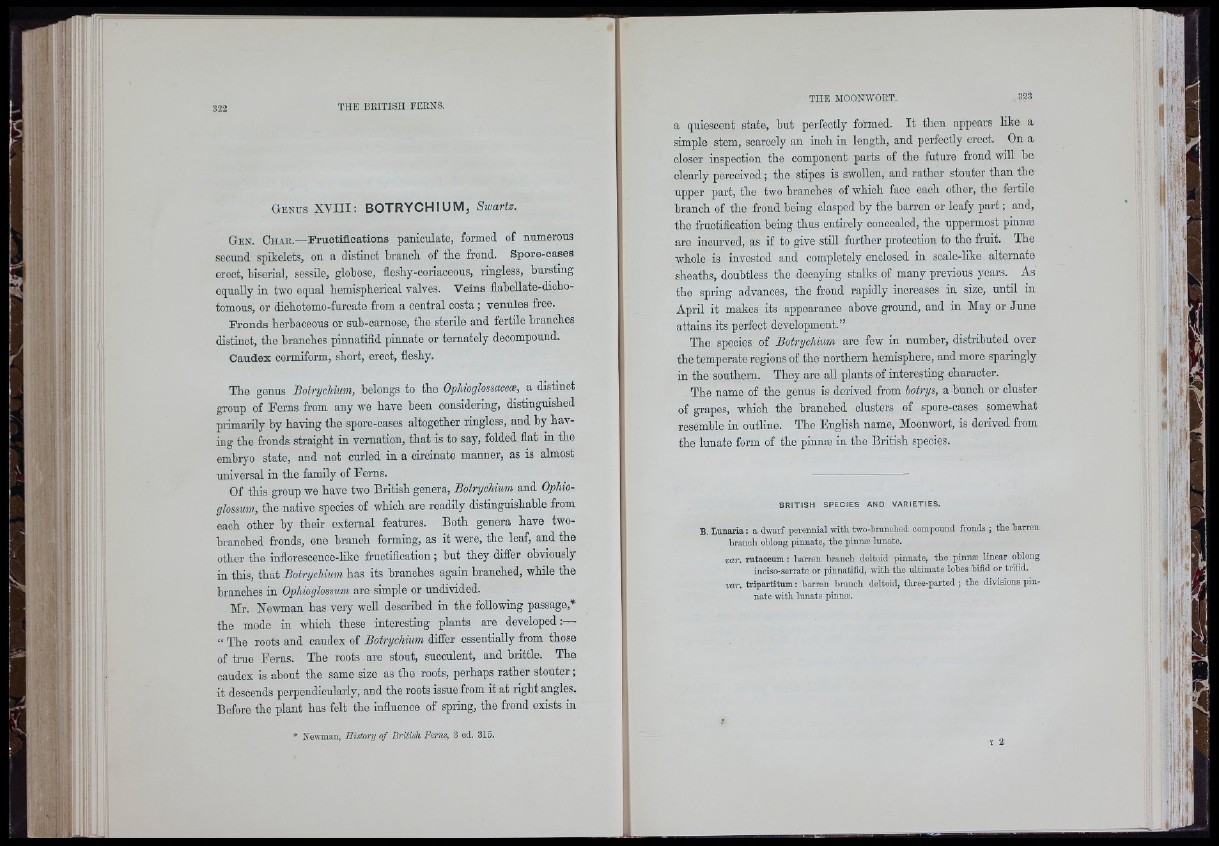
G e n u s XVIII; B O T R Y C H I U M , Swartz.
Gen. Chak.—F ructifleations paniculate, formed of numerous
socund spilcclets, on a distinot branch of the frond. Spore-oases
erect, biscrial, sessile, globose, fleshy-coriaceous, ringless, bursting
equally in two equal hemispherical valves. Veins flabellate-dicho-
tomous, or dichotomo-furcate from a central oosta ; venules free.
Fronds herbaceous or suh-oarnose, the sterile and fertile branches
distinct, the branches pinnatifid pinnate or temately decompound.
Caudex cormiform, short, erect, fleshy.
The gonus BotrycMim, belongs to the OphioglossacecB, a distinct
group of Ferns from any we have been considering, distinguished
primarily hy having the spore-cases altogether ringless, aud hy having
the fronds straight in vernation, that is to say, folded flat in the
embryo state, and not curled in a circinate manner, as is almost
universal in the family of Ferns.
Of this group we have two British genera, Botrychium and Ophioglossum,
the native species of which are readily distinguishahle from
each other by their external features. Both genera have two-
hranohed fronds, one branch forming, as it were, the leaf, and the
other the infloresoence-like fruotification; but they differ obviously
in this, that Botrychium has its branches again branched, while the
branches in Ophioglossum are simple or undivided.
Mr. Newman has very well described in the Mowing passage,*
the mode in which these interesting plants are developed:—
“ The roots and caudex of Botrychium differ essentially from those
of true Ferns. The roots are stout, succulent, and brittle. The
caudex is about the same size as the roots, perhaps rather stouter;
it descends perpendicularly, and the roots issue from it at right angles.
Before the plant has felt the influence of spring, tho frond exists in
* Newman, History o f British Ferns, 3 ed. 315.
a quiescent state, but perfectly formed. It then appears like a
simple stem, scarcely an inch in length, and perfectly erect. On a
closer inspection tho component parts of the future frond will ho
clearly perceived ; tho stipes is swollen, and rathor stouter than tho
upper part, the two branches of which face each other, tho fertile
branch of tho frond being clasped by the barren or leafy part ; and,
the fructification being thus entirely concealed, the uppermost pinnæ
are incurved, as if to give still further protection to the fruit. The
whole is invested and completely enclosed in soale-lilre alternate
sheaths, doubtless the decaying stalks of many previous years. As
tho spring advances, the frond rapidly increases in size, until in
April it makes its appearance above ground, and in May or June
attains its perfect development.”
The species of Botrychium are few in number, distributed over
the temperate regions of the northern hemisphere, and more sparingly
in the southern. They are all plants of interesting character.
The name of the genus is derived from botrys, a hunch or cluster
of grapes, which the branched clusters of spore-cases somewhat
resemble in outline. The English name, Moonwort, is derived from
the lunate form of the pinnæ in the British species.
B RIT ISH SPECIES AND VARIETIES.
B. Limaria: a dwarf perennial w ith two-hrauched compound fronds ; th e barren
branch ohlong pinnate, th e pinnæ lunate.
m r . rutaceum : barren branch deltoid pinnate, th e pinnæ linear ohlong
inciso-serrate or pinnatifid, with th e u ltima te lobes bifid or trifid.
m r . trip a rtitum : barren branch deltoid, three-parted ; th e divisions p in n
ate with lunate pinnæ.
t e a
4
I fj
c '.yi
iM
y
I
Jll
IM
J i i|
•i! iriivil
ill*!
— . i J U